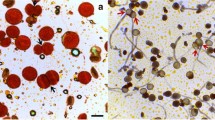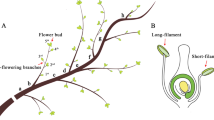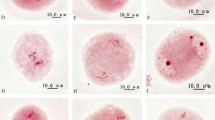Abstract
Natural triploids of Populus tomentosa (2n = 3x = 57) are presumably the result of sexual polyploidization through the union of normal n female gametes and numerically unreduced (2n) male gametes. In our microscopic study of microspore mother cells (MMCs) of diploid P. tomentosa (2n = 2x = 38), we observed that the first meiotic division was normal but that the second division was characterized by frequent abnormal spindle orientation (parallel, tripolar, and fused spindles) and premature cytokinesis. The parallel, fused spindles and premature cytokinesis were considered to be leading dyad formation, and tripolar spindles seemed to be leading triad formation at the tetrad stage. There was a higher frequency of parallel spindles than other spindle forms, but there were no significant correlations between parallel spindles and dyads. An indirect immunofluorescence examination of meiosis II revealed that four tetragonally arranged nuclei were formed in MMCs with parallel spindles and that there were radial microtubules systems (RMSs) among these four nuclei, leading to the tetragonal tetrad. In some MMCs, however, the parallel spindles led to the gathering of one or two non-sister groups of chromosomes, causing an incorporation of RMSs from two daughter nuclei. Thus, the incorporated RMSs established three or two nuclear cytoplasmic domains for the control of division plane, resulting in either triad or dyad formation. These results provide new insights on the mechanism of parallel spindles leading to numerically unreduced pollen formation and on the selection and utilization of this type of pollen in polyploid breeding of P. tomentosa.




Similar content being viewed by others
References
Akutsu M, Kitamura S, Toda R, Miyajima I, Okazaki K (2007) Production of 2n pollen of Asiatic hybrid lilies by nitrous oxide treatment. Euphytica 155:143–152. doi:10.1007/s10681-006-9317-y
Bradshaw HD, Stettler RF (1993) Molecular genetics of growth and development in Populus. I. Triploidy in hybrid poplars. Theor Appl Genet 86:301–307. doi:10.1007/BF00222092
Bretagnolle F, Thompson JD (1995) Gametes with the somatic chromosome number: mechanisms of their formation and role in the evolution of autopolyploid plants. New Phytol 129:1–22
Brown RC, Lemmon BE (1991) Pollen development in orchids 2. The cytokinetic apparatus in simultaneous cytokinesis. Protoplasma 163:9–18. doi:10.1007/BF01322286
Brown RC, Lemmon BE (1992) Control of division plane in normal and griseofulvin-treated microsporocytes of Magnolia. J Cell Sci 103:1031–1038
Camadro EL, Saffarano SK, Espinillo JC, Castro M, Simon PW (2008) Cytological mechanisms of 2n pollen formation in the wild potato Solanum okadae and pollen-pistil relations with the cultivated potato, Solanum tuberosum. Genet Resour Crop Evol 55:471–477. doi:10.1007/s10722-007-9254-1
Carputo D, Barone A (2005) Ploidy level manipulations in potato through sexual hybridisation. Ann Appl Biol 146:71–79. doi:10.1111/j.1744-7348.2005.04070.x
Carputo D, Barone A, Frusciante L (2000) 2n gametes in potato: essential ingredients for breeding and germplasm transfer. Theor Appl Genet 101:805–813. doi:10.1007/s001220051547
Conicella C, Capo A, Cammareri M, Errico A, Shamina N, Monti LM (2003) Elucidation of meiotic nuclear restitution mechanisms in potato through analysis of microtubular cytoskeleton. Euphytica 133:107–115. doi:10.1023/A:1025636321757
d’Erfurth I, Jolivet S, Froger N, Catrice O, Novatchkova M, Simon M et al (2008) Mutations in AtPS1 (Arabidopsis thaliana Parallel Spindle 1) lead to the production of diploid pollen grains. PLoS Genet 4(11):1000274. doi:10.1371/journal.pgen.1000274
Den Nijs TPM, Peloquin SJ (1977) 2n gametes in potato species and their function in sexual polyploidization. Euphytica 26:585–600. doi:10.1007/BF00021684
Genualdo G, Errico A, Tiezzi A, Conicella C (1998) α-Tubulin and F-action distribution during microsporogenesis in a 2n pollen producer of Solanum. Genome 41:636–641
Harlan JR, De Wet JMJ (1975) On Ö. Winge and a prayer: the origins of polyploidy. Bot Rev 41:361–390
Jacob Y, Pierret V (2000) Pollen size and ploidy level in the genus Rosa. Acta Hortic 508:289–292
Jauhar PP (2003) Formation of 2n gametes in durum wheat haploids: sexual polyploidization. Euphytica 133:81–94. doi:10.1023/A:1025692422665
Kang XY (2002) Mechanism of 2n pollen occurring in Chinese white poplar. J Beijing For Univ 24(5, 6):67–70
Mendiburu AO, Peloquin SJ, Mok DWS (1974) Potato breeding with haploids and 2n gametes. In: Kasha K (ed) Haploids in higher plants. University of Guelph, Guelph
Mok DWS, Peloquin SJ (1975) Three mechanisms of 2n pollen formation in diploid potatoes. Can J Genet Cytol 17:217–225
Muntzing A (1936) The chromosomes of a giant Populus tremula. Hereditas 21:383–393
Orjeda G, Freyre R, Iwanaga M (1990) Production of 2n pollen in diploid Ipomoea trifida, a putative wild ancestor of sweet potato. J Hered 81:462–467
Ortiz R, Peloquin SJ (1994) Effect of sporophytic heterozygosity on the male gametophyte of the tetraploid potato (Solanum tuberosum L.). Ann Bot 73:61–64
Pfeiffer TW, Bingham ET (1983) Abnormal meiosis in alfalfa, Medicago sativa: cytology of 2n eggs and 4n pollen formation. Can J Genet Cytol 25:107–112
Ramanna MS (1979) A re-examination of the mechanisms of 2n gamete formation in potato and its implications for breeding. Euphytica 28:537–561. doi:10.1007/BF00038921
Ramanna MS (1983) First division restitution gametes through fertile desynaptic mutants of potato. Euphytica 32:337–350. doi:10.1007/BF00021442
Ramsey J (2007) Unreduced gametes and neopolyploids in natural populations of Achillea borealis (Asteraceae). Heredity 98:143–150. doi:10.1038/sj.hdy.6800912
Ramsey J, Schemske DW (1998) Pathway, mechanisms, and rates on polyploid formation in flowering plant. Annu Rev Ecol Syst 29:467–501
Rieseberg LH, Willis JH (2007) Plant speciation. Science 317:910–914. doi:10.1126/science.1137729
Seitz FW (1954) The occurrence of triploids after self-pollination of anomalous androgynous flowers of a grey poplar. Z Forstgenet 3(1):1–6
Sugiura A, Ohkuma T, Choi YA, Tao R, Tamura M (2000) Production of nonaploid (2n = 9x) Japanese persimmons (Diospyros khaki) by pollination with unreduced (2n = 6x) pollen and embryo rescue culture. J Am Soc Hortic Sci 125(5):609–614
Tavoletti S, Mariani A, Veronesi F (1991) Cytological analysis of macro- and microsporogenesis of a diploid alfalfa clone producing male and female 2n gamete. Crop Sci 31:1258–1263
Tavoletti S, Pesaresi P, Barcaccia G, Albertini E, Veronesi F (2000) Mapping the jp (jumbo pollen) gene and QTLs involved in multinucleate microspore formation in diploid alfalfa. Theor Appl Genet 101:372–378. doi:10.1007/s001220051493
Van Tuyl JM, Lim K-B (2003) Interspecific hybridization and polyploidisation as tools in ornamental plant breeding. Acta Hortic 612:13–22
Veilleux R (1985) Diploid and polyploid gametes in crop plants: Mechanisms of formation and utilization in plant breeding. Plant Breed Rev 3:253–288
Veilleux R, McHale NA, Lauer FI (1982) 2n gametes in diploid Solanum: frequency and type of spindle abnormalities. Can J Genet Cytol 24:301–314
Winton L, Einspahr DW (1970) Tetraploid aspen production using unreduced triploid pollen. For Sci 16:180–182
Yao CL, Pu JW (1998) Timber characteristics and pulp properties of the triploid of Populus tomentosa. J Beijing For Univ 20:18–21
Zhang S, Qi L, Chen C, Li X, Song W, Chen R et al (2004) A report of triploid Populus of the section Aigeiros. Silvae Genet 53:69–75
Zhang Z, Kang X, Zhang P, Li Y, Wang J (2007) Incidence and molecular markers of 2n pollen in Populus tomentosa Carr. Euphytica 154:145–152. doi:10.1007/s10681-006-9280-7
Zhu ZT, Kang XY, Zhang ZY (1998) Studies on selection of natural triploid of Populus tomentosa. Sci Silvae Sin 34:22–31
Acknowledgements
We thank the Guan County nursery garden of Shandong province for providing the plant materials. The research was supported by the National Natural Science Foundation of China (Grant No. 30471407).
Author information
Authors and Affiliations
Corresponding author
Rights and permissions
About this article
Cite this article
Zhang, Z., Kang, X. Cytological characteristics of numerically unreduced pollen production in Populus tomentosa Carr.. Euphytica 173, 151–159 (2010). https://doi.org/10.1007/s10681-009-0051-0
Received:
Accepted:
Published:
Issue Date:
DOI: https://doi.org/10.1007/s10681-009-0051-0




